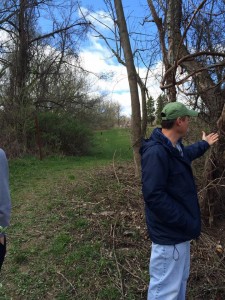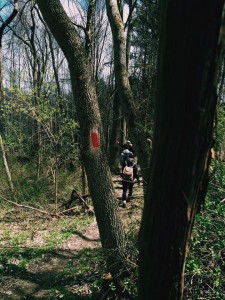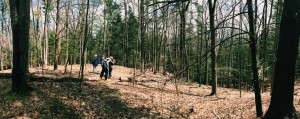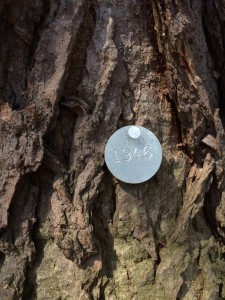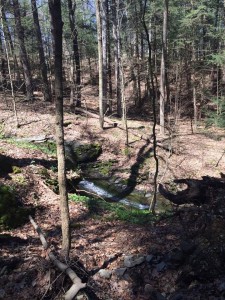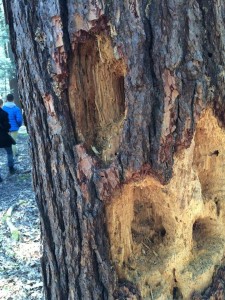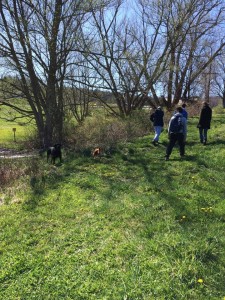The speaker at the last Rose Café was Andy Zepp and the topic, the Finger Lakes Land maintenance and Trust. I learned that there is a lot to consider when managing these lands, and a lot more work that FLL staff do than simple “maintenance” implies. Apparently staff have to consider both public access and sentiment when deciding how to regulate land access, one of several jobs I hadn’t considered that FLL and Cornell Plantation staff have. Other such jobs included their responsibilities to both the land and people as well as fundraising. I left with a better understanding of Ithaca’s conservation efforts, and realized that Ithaca is not an anomaly as I once thought. Coming from the city, being environmentally friendly is sometimes presented as an option, a hobby, or impressive, so seeing compost bins daily and such beautiful landscape, I thought Ithaca was “special”, but what I learned is that it’s not. Instead why newcomers may have that perception is because locals are so invested in the well-being of their land, and they show it. I think Ithaca is a great place to build a desire to care for the community, land and people, as well as to get the resources to do so knowledgeably.
Author Archives: kaj93
Four-Years’ Time
The lab is out of the way, so upon arrival, I got a glimpse of campus I’ve never seen before. My first impression was that the lab seemed a bit intimidating, and as our “tour guides” confirmed, on the older side of things. Walking uphill, I expected that it would be more flashy, given the university, but as my group was later told, the department is very frugal with the limited amount of funding they receive. So I thought it was interesting that even this university “struggles” with funding at least to some extent. My other expectation was that the building would be less underground, and so that was a bit distracting and nerve-racking. However, nervousness aside, I thought it was interesting that we, and students at this university, had access at all. Given that I’m a year out of high school, realizing that in four years I, like GRF David, could have official access to this lab, felt a bit like a culture shock. I don’t necessarily think I will end up working in this building specifically, but the fact that the option is available, was a bit of a wake-up call. In other words, it was stressful. So my last impression is that I, as an undeclared major, still have plenty to consider in my next three years, and that’s still intimidating to me.
Money Well Spent
My friend Deborah, from Massachusetts, came to visit the weekend of this trip. I’d been to the market before, however, this was the first time with company I knew. We did a lot of browsing, I imagine given the vending prices, most college students do. I do want to confirm, however, that there are cost-friendly ways to enjoy the Farmer’s Market, especially when you can split costs with a friend. Both of us bought from the Cuban vendor and shared cotton candy, so that we could buy more later. Deborah bought a necklace and donuts for us both, and so I can say definitively that coming with a friend is a better experience than being solo. Especially since a few hours, moreover, a weekend of uninterrupted of quality time is not usual here or otherwise, so it was appreciated. I’m looking forward to trying the market’s maple cookies and grabbing some food from the Ethiopian food vendor in my next three years, as well as getting a job so I can leave with some snacks for home. After leaving, I was well-fed, a little more broke, but I also had a good roll of photos, some of my best. I’ve shared three below:
Although urban areas offer a lot of things to do, my friend and I both agreed that our markets—maybe—don’t compare to the one here. Boston markets are great, in fact, they host my favorite donut place and are in the middle of some of my favorite squares, but they don’t necessarily offer the diversity in crafts that this one does. A bit different from other markets I’m used to, Ithaca Market isn’t crowded with other shops or some hole in the “hustle and bustle” of the city. It’s a nice place to get away from college life, which I really needed to do, and to spend money well and healthily. So five star grapes out of five star grapes.
Difficulty Developing Passion
My friend has been in social justice youth groups, and is interested in social reform work. I don’t necessarily have the same interest, but do value such a career. I would like to be socially-involved, however, I don’t know if I have the energy to have both a satisfying and impactful job. My friend feels the same.
Laura Rodriguez de Simons, our speaker, talked about reconciling passion with a healthy personal lifestyle. I asked, “Do you think there is a place for the less passionate in social justice work?”, and she said, noting that she was an idealist, that she believes everyone has some investment in sociocentric issues. I pried a bit, and so it’s probably clear that I’m of a somewhat different mindset. I think most people, I won’t say all, have emotional investment in certain issues, but not all’s interests meet the threshold of activism. So how do you achieve the investment to prompt proactive and purposeful change? And can you? The answer I usually hear is education and or some variation of “you just do it”, but I wonder if passion is always “found” or if sometimes it must be developed more “painstakingly”.
Transitioning Between Insider and Outsider Culture
I initially wanted to attend this concert because I recognized a name on the program: Tchaikovsky, which I became acquainted with through my Music and Diplomacy class. Going into Bailey, I recognized some kids from marching band and previous (and current) classes. I note this not because I was particularly surprised, but because it was a little odd to identify who the orchestra kids were when for the past four years I was in their position. In high school, I used to be in marching and concert band, so I had few opportunities to view or participate in performances outside my own. So Sunday was a little bit of change of pace for me, the music was soothing and as always I ended up with a few new pictures on my phone. Despite, the “culture shock” of becoming somewhat of an outsider to the “music world”, the concert was all in all enjoyable. Hearing the two Symphony’s flautists made me proud to one of their peers (in a musical sense), but also really sad that I haven’t touched an instrument for almost a year since graduating and a flag since last semester when I first joined color guard and the CU band. This concert gave me some nostalgia, but hopefully will prompt me to make something productive of the accompanying emotions.
Living Through My Camera
It had been a while since I last went hiking. I got a little messy, learned about some forest dynamics, and, because I was warned about ticks, later that day I learned about those too. I think going on my hike through Cornell Plantations was a good opportunity to get some fresh air and some nice pictures, all of which I would have missed otherwise.
Starting off the trip, I got a few snaps of these dogs who live in a house neighboring the plantations. We were initially scared when we had the bigger one coming towards us, but luckily he was friendly and the little one loud but not bold. If you look in the background you can see them walking away, and in the front is our guide, Director Bittner.
So we continued on, and as you’ll be able to see from most of my photos I stayed behind taking pictures.
Mr. Bittner was telling the group about the meaning of the red marks, and about differentiating between the meaning of the single and double dash. After taking my picture, I ran up to meet the rest of the group, and that was kind of the dynamic for the rest of the trip.
In between my allergic reactions and listening to Mr. Bittner, I played around with the panoramic feature on my iPhone. Luckily for me, no one was moving here so I ended up with one good wide-shot. So we continued, stopping every once and a while to hear from Mr. Bittner, and to sneak in some photos. The weather was a little chilly at first, but as we continued on uphill more tolerable. On our trip, we started out talking about finding clues of human land development.
From the use of barbed wire, population regulation, and tags, such as the one in the photo above, we learned how both humans and other organisms interact with the environment to suit their needs. This led to a conversation about how species interact with one another, deer with native plants, humans with the growing number of deer, and my favorite bird courtship, which I thought was kind of funny. Apparently birds aren’t just superficial, but some are driven towards the bright and vocal as opposed to the strong because the aesthetically-pleasing give off the illusion of strength by drawing so much attention to themselves. Other such interactions include tagging trees that need to be injected with pesticides to mitigate the impact of invasive species. As Director Bittner explained the holes we’d seen were dug out by large woodpeckers.
All in all it was a nice trip, we were both greeted and shooed away by some cute dogs, and on our way back I found a country restaurant, Stella’s, that I can check out in my next three years. I ended with a nice set of photos, I learned a bit about the plantation as well as photography. Going back to campus, Director Bittner introduced me to the thirds-rule, and now I have a new term under my belt. We looked through my photos, I found a few gems, my favorites being some of my last.

Looking through my pictures afterwards, I saw this dog’s expression and realized it was very expressive
It was a trip I’m glad I had the opportunity to take. Thank you to the Rose Scholar’s program, Director Bittner, Cornell Plantations, and the other scholars for a nice day. For more pictures contact me through my netid, kaj93, I’ll be glad to share.
Am I Missing Something?
As probably anyone reading this post knows, the movie was about slavery and, I think can be said definitively, the hypocrisy of the Romanians’ interactions with the Gypsy slaves. But before I go into my take on the film and an “exclusive interview” with one of the cinema’s ushers. I want to bring up some questions that were on my radar that I think are important to keep in mind while watching the movie: Why is the movie in black and white?, is that an allusion to how the characters view their world?, and lastly, why were the people in the theater laughing, is the movie really as funny as it seemed or is there something “funny” about the people with whom I was watching this movie?
For me the first few are easiest to answer because I think my second question is the answer to the first. They believe their world is black and white. The whole point of this movie—I think—is the “realization”, which I’ll call it for the sake of this post, the protagonists have: they are not the only sparks of fire in the world, a reference you’ll get if you watch the movie.
The film starts out on a funny note with a priest carrying on about the Romanian situation in a non-PC tantrum in the woods to which the father and son respond agreeably. With the father, Costandin, being sick, and running “errands” for Romanian masters with his son, Ionita, the man and his son are convinced they are the common men who bear the burden of society. Constandin preaches to his son that they must work hard and persevere in spite of their burdens, and promises to do well by his son…to make a man out of him. He has Ionita practice with his sword, presumably, to be used against slaves, gets his son to lose his virginity to a prostitute, and promises that he will make Ionita an officer. A big theme of the movie is how it ironically parallels a hero’s quest in spite of its characters being seemingly kind of lame. They have stereotypically backwards thinking, Constandin fails to please the same prostitute who claimed his son was a “bull” in bed, and the list goes on. Spoiler alert!!!!!!!! After bringing back the slave, thinking they have the power to object against his torture, Constandin is smacked and shooed away in front of his son, the slave is punished, and they walk away, unlike most hero’s quests, not with the reward but redrawn to their mission: to bear the burdens of the world, as they see it.
As I omitted earlier, I arrived late to the movie, so I talked to an usher afterwards to get what I missed in the first few minutes. Unfortunately I’ll have to paraphrase, but he put it pretty eloquently, “It’s a movie about who’s the master,” and because I feel like he used this word (sorry if I misspeak) it is about “nested” hierarchies.
The movie, I think for the “father & son duo” is about unveiling who the real man behind the scenes is and revealing who the real slaves are. The journey ends with, and I hope this analogy supports my last statement, the Matryoshka nesting doll, kind of man-behind-the-curtain, of realizations, and perhaps that is what made it so ironic, but funny I don’t know. The Polonius-esque babbling, amusing, but the backwards-thinking, while foolish-seeming in contrast to the more liberal-thinking here, funny? Watching pride be dampened by the inability to satisfy the same woman who had sex with your son, funny? Don’t know and right now can’t say.




